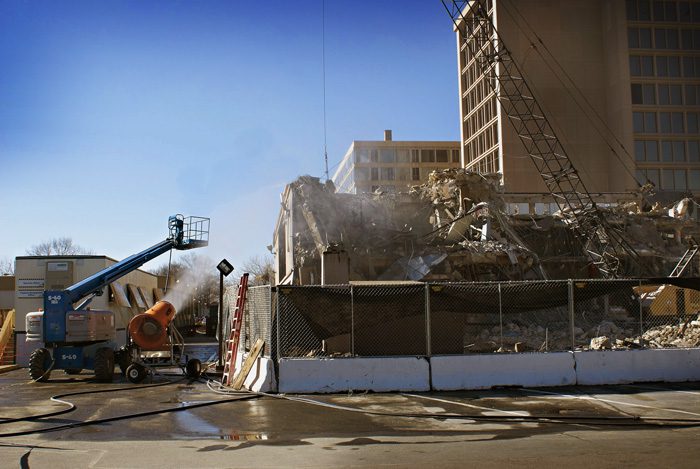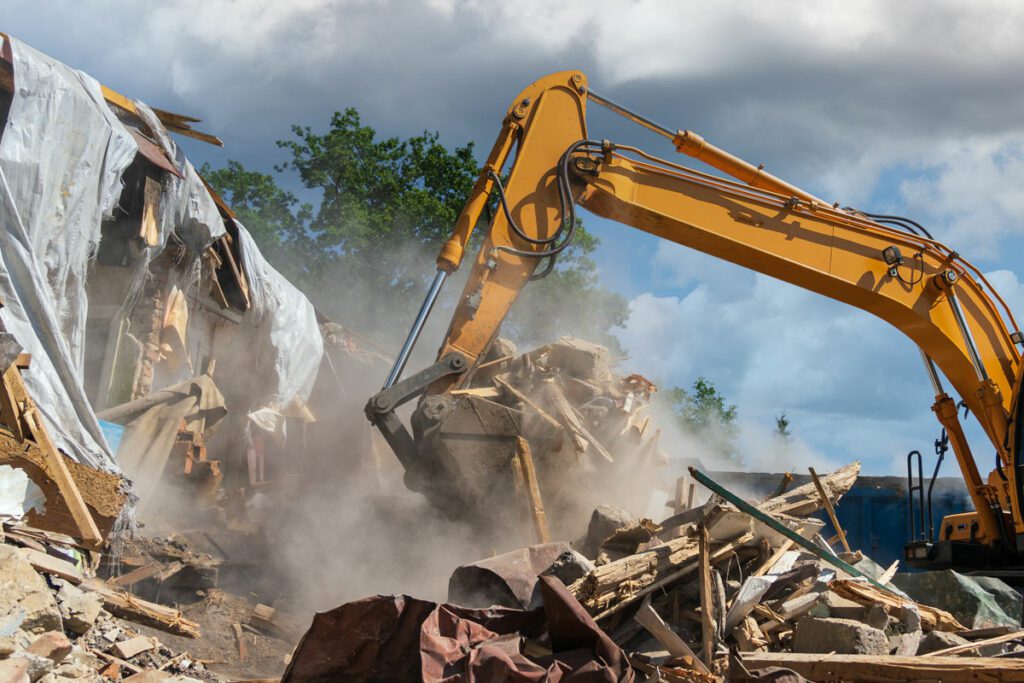"By nature, concrete work generates a lot of dust. We felt we had to take strong measures for control on this project"
- Terry Anderson
Executive VP
From the outset, it was clear that a demolition in a crowded urban area just 50 feet (21 meters) from a Metro station tunnel entrance would require extraordinary dust control precautions.
“The Metro station entrance has a way of creating a vacuum. If the wind is blowing the wrong way, the dust gets sucked right down," said Terry Anderson, Executive VP of Wrecking Corporation of America (Alexandria, Virginia, USA).
Waterside Mall, a 4-story, heavily-reinforced concrete structure totaling 1.2 million square feet (approx. 111,484 square meters).

"The site was also hemmed in on three sides by structures that needed to be preserved, so we had to do a very selective removal while protecting the entire surrounding area from the nuisance and potential hazard of airborne dust,” said Anderson.
After researching possible dust suppression solutions, Anderson decided to rent a DustBoss DB-60. The unit atomizes water droplets to the optimum size for particle capture, launching them 200 feet or more with a powerful 25 HP fan that generates 30,000 CFM (nearly 850 cubic meters per minute).
With its built-in oscillation, the DB-60 can effectively cover nearly half an acre (about .2 hectares) with a fine, dust-trapping mist.
The portable dust control equipment
The DB-60 is a fully automatic ducted fan design, mounted on a wheeled carriage so it can be easily located to accommodate wind direction or specific work areas. The unit delivers an adjustable elevation from 0-50° and 40° of oscillation, providing WCA crews with outstanding coverage.
Anderson’s crews run the DB-60 with power from a portable generator and water supplied by a 1-1/2" fire hose. A 10 HP (7.5 KW) booster pump elevates water pressure in the DB-60 as high as 200 PSI for outstanding particle suppression.
The demolition
WCA began the project in November of 2007 and the old structure did not go easily.
“This was one of the more difficult buildings we’ve taken down in some time,” Anderson said. He has no explanation for why a decades-old mall was built with 20-inch (51 cm) floor slabs, when the standard is 9 inches (about 23 cm).
“We had to fight down every step. It’s also the largest contiguous building that the company has ever removed."
In addition to the crowded urban environment, the project was complicated by structures that had to be preserved, including a deli attached to the nearby grocery store. Unfortunately, sections of the structure to be demolished were directly on top of it.
“We saw cut through the 20-inch slabs of concrete,” Anderson said. “Then we had to carefully remove all debris, while protecting the integrity of the buildings to remain and controlling the large amounts of dust that were generated by all those activities.”
“We had to carefully remove all debris, while protecting the integrity of the buildings to remain and controlling the large amounts of dust that were generated by all those activities.”
- Terry Anderson
Executive VP
WCA employed a high-reach excavator for the general demolition work, a 100,000 lb (45,359 kg) Komatsu PC400 with an 85 ft (26 meter) boom. Kinshofer dedicated shears with 360 degree rotation were used for cutting the extensive amount of reinforcing steel, more than 5,000 tons overall.
Anderson’s crews also made extensive use of a 90-ton truck crane and wrecking ball. “It’s a technology that virtually never breaks down,” he said. “And it leaves a small carbon footprint.”
WCA also used a 140,000 lb (63,503 kg) Caterpillar 365 track-mounted excavator to take down the structures, along with three Hitachi 450 excavators with bucket attachments and four Hitachi 330 excavators with a variety of attachments that included concrete pulverizers and demolition hammers.
WCA performed all concrete crushing and recycling on-site, with an Extec C10 crusher used to process approximately 70,000 cubic yards (53,519 cubic meters) of material. The crushed product was used for non-structural fill and backfilling.
“By nature, concrete work generates a lot of dust,” Anderson said. “We felt we had to take strong measures for control on this project. The DustBoss did such a good job that we decided to purchase the unit,” he said.
CUSTOMER
Wrecking Corporation of America
LOCATION
Alexandria, VA (USA)
CHALLENGE
Control dust from the demolition of the old Waterside Mall, a 4-story, heavily-reinforced concrete structure. The crowded urban location and close proximity to the local Metro station tunnel entrance required extraordinary precautions to prevent the nuisance and potential hazard of airborne dust.
SOLUTION
Rental DB-60
RESULTS
The DB-60 has proven to be an excellent solution to the dust control solution on the Waterside Mall project, effectively suppressing dust, both surface and airborne particles. “We felt we had to take strong measures for control on this project,” said Executive VP Terry Anderson. “The DustBoss did such a good job that we decided to purchase the unit.”
WRECKING CORPORATION OF AMERICA
has completed hundreds of high-profile projects in downtown Washington, D.C. and the surrounding metro area since the company's inception in 1974, including 1900 Pennsylvania Avenue and the former Washington Convention Center. WCA specializes in the challenges of commercial demolition and excavation, with expertise in cramped urban locations as well as sprawling multi-building complexes.
"By nature, concrete work generates a lot of dust. We felt we had to take strong measures for control on this project"
- Terry Anderson
Executive VP
From the outset, it was clear that a demolition in a crowded urban area just 50 feet (21 meters) from a Metro station tunnel entrance would require extraordinary dust control precautions.
“The Metro station entrance has a way of creating a vacuum. If the wind is blowing the wrong way, the dust gets sucked right down," said Terry Anderson, Executive VP of Wrecking Corporation of America (Alexandria, Virginia, USA).
Waterside Mall, a 4-story, heavily-reinforced concrete structure totaling 1.2 million square feet (approx. 111,484 square meters).

"The site was also hemmed in on three sides by structures that needed to be preserved, so we had to do a very selective removal while protecting the entire surrounding area from the nuisance and potential hazard of airborne dust,” said Anderson.
After researching possible dust suppression solutions, Anderson decided to rent a DustBoss DB-60. The unit atomizes water droplets to the optimum size for particle capture, launching them 200 feet or more with a powerful 25 HP fan that generates 30,000 CFM (nearly 850 cubic meters per minute).
With its built-in oscillation, the DB-60 can effectively cover nearly half an acre (about .2 hectares) with a fine, dust-trapping mist.
The portable dust control equipment
The DB-60 is a fully automatic ducted fan design, mounted on a wheeled carriage so it can be easily located to accommodate wind direction or specific work areas. The unit delivers an adjustable elevation from 0-50° and 40° of oscillation, providing WCA crews with outstanding coverage.
Anderson’s crews run the DB-60 with power from a portable generator and water supplied by a 1-1/2" fire hose. A 10 HP (7.5 KW) booster pump elevates water pressure in the DB-60 as high as 200 PSI for outstanding particle suppression.
The demolition
WCA began the project in November of 2007 and the old structure did not go easily.
“This was one of the more difficult buildings we’ve taken down in some time,” Anderson said. He has no explanation for why a decades-old mall was built with 20-inch (51 cm) floor slabs, when the standard is 9 inches (about 23 cm).
“We had to fight down every step. It’s also the largest contiguous building that the company has ever removed."
In addition to the crowded urban environment, the project was complicated by structures that had to be preserved, including a deli attached to the nearby grocery store. Unfortunately, sections of the structure to be demolished were directly on top of it.
“We saw cut through the 20-inch slabs of concrete,” Anderson said. “Then we had to carefully remove all debris, while protecting the integrity of the buildings to remain and controlling the large amounts of dust that were generated by all those activities.”
“We had to carefully remove all debris, while protecting the integrity of the buildings to remain and controlling the large amounts of dust that were generated by all those activities.”
- Terry Anderson
Executive VP
WCA employed a high-reach excavator for the general demolition work, a 100,000 lb (45,359 kg) Komatsu PC400 with an 85 ft (26 meter) boom. Kinshofer dedicated shears with 360 degree rotation were used for cutting the extensive amount of reinforcing steel, more than 5,000 tons overall.
Anderson’s crews also made extensive use of a 90-ton truck crane and wrecking ball. “It’s a technology that virtually never breaks down,” he said. “And it leaves a small carbon footprint.”
WCA also used a 140,000 lb (63,503 kg) Caterpillar 365 track-mounted excavator to take down the structures, along with three Hitachi 450 excavators with bucket attachments and four Hitachi 330 excavators with a variety of attachments that included concrete pulverizers and demolition hammers.
WCA performed all concrete crushing and recycling on-site, with an Extec C10 crusher used to process approximately 70,000 cubic yards (53,519 cubic meters) of material. The crushed product was used for non-structural fill and backfilling.
“By nature, concrete work generates a lot of dust,” Anderson said. “We felt we had to take strong measures for control on this project. The DustBoss did such a good job that we decided to purchase the unit,” he said.
Implement Dust Control at Your Jobsite!
Receive a FREE quote and talk to a dust control specialist today to stop fugitive dust!
Get A Quote
More on BossTek
Subscribe and Stay Up-to-Date!
Receive a monthly newsletter keeping you up-to-date on the latest in dust and odor control.
Subscribe





